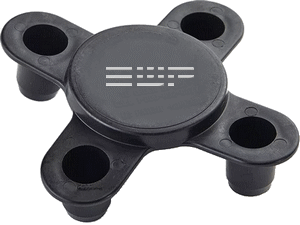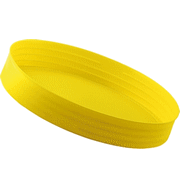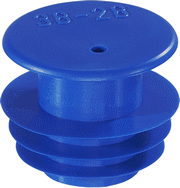Flange (Pipe) protectors
Flange protectors are designed to protect flanges from damage during transportation or exposure to corrosive elements. These products are usually made of plastic, polyvinyl chloride (PVC), silicone or vinyl.
Some suppliers group flange protectors with caps, closures, handles, inserts, plugs, stoppers and other tools for pipes and tubes. Other suppliers list their products separately and indicate whether they are suitable for pipe flange protection or pipe flange protection.
Product specifications for flange protectors include the construction material, fastening method and type or style. Most flange protectors are designed to be bolted, clamped or pushed into place. Some push-on products are designed for use with adhesives. Flange protectors may have a raised or full surface and may be listed as disks or covers.

Stud hole flange protector
Features of flange protectors include quick assembly and suitability for high-pressure use. The construction material is an important parameter when choosing flange protectors. Plastic flange protectors are usually made of thermoplastics such as low-density polyethylene (LDPE) and high-density polyethylene.
LDPE has excellent resistance to acids, alcohols, bases and esters. HDPE resists various solvents and is used in many commercial applications.
PVC flange protectors are made of polyvinyl chloride (PVC), a biologically and chemically resistant thermoplastic polymer widely used in food processing and water transportation applications.
Silicone flange protectors are valued for the thermal stability and water repellency that silicone provides.
Vinyl flange protectors include products made from PVC, as well as flange protectors made from polyvinyl acetate (PVAc) and polyvinyl alcohol (PVA).
There are many different types of flange protectors. Examples include quick-mount covers with bolts, Society of Automotive Engineers (SAE) high-pressure flange covers and insert flange covers. Bolted quick-mount covers do not require fasteners and are designed to fit into flange bolt holes.
SAE high-pressure flange covers also do not require fasteners and are approved for high-pressure use by the SAE.
Insert flange covers have flexible fins for a snug fit in the bore. Flange protection products such as integral arrow-clip flange discs, full-surface flange covers, raised-surface flange plugs, full-surface flange discs and raised-surface flange discs are also available.
Pros and cons of flange protectors

The stud hole flange protector pictured above is an excellent solution. With that protector, the raised face is well protected as 4 stud hole connectors are pushed into the bolt holes, keeping the cap firmly in place.
Another great advantage of this flange protector is that a flange connection cannot be made conventionally. The cap will have to be removed first, so that all the bolts can be assembled; a good reminder for the mechanic. However, there are other covers that protect a flange very well; consider this as an example.

In practice, I have experienced several times that the cap was still in place even while the gasket was in place and all the bolts were tightened. This can unfortunately happen, if a flange protector as shown in the picture above, is applied. So think carefully before purchasing flange protectors.
So far, flange protectors have been mentioned
However, ends of e.g. pipes and fittings must also be protected for various reasons. The reasons may be, to protect the bevels of a pipe or fitting from damage or to prevent debris etc. from entering a pipe or fitting.
As with flange protectors, there are many different types of pipe and fitting protectors. The choice is less extensive, and in priciepe the protectors can be applied internally or externally.



Compared to flange protectors, the choice of protectors for pipe and fittings is more limited, and actually there is not much you can go wrong. Of course, an internal protector should not be smaller ![]() than needed for a particular pipe.
than needed for a particular pipe.
This article explained a small number of protector caps. However, many more types are available on the market, not all of them can be described on this page.
Some images from the field



I hope the 3 pictures above make it clear what can happen if no covers are used when pipe ends are open and not protected. This applies not only to pipe spools in the field, but also in a workshop where other impurities can get into the inside of a pipe spool.